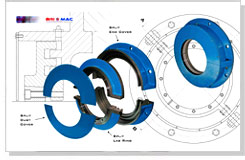The casting patterns must be designed in a way to enhance the solidification and casting process reliability of the casting, costs related to tooling and production are reduced, and stress concentrators are condensed.
The casting pattern designer has to observe the flow of steel into the mold to avoid turbulent flow and producing rapid fill. During the process of solidification, a mold must have been designed to suitably place the appropriate sized risers to supply the molten metal into casting.
The pattern engineer also has a responsibility of determining the process of metal casting. He identifies the original designs of the casting by making some considerations. Once those considerations are identified, "a required set of decision steps" are developed for a casting design and a pattern design for creating the mold. They are:
- To locate the direction of the parting line and adjust the component within the mold.
- Draft angles and radii of the sharp edges are properly examined.
- To recognize and abolish the hotspots within the component.
- To encourage the directional-solidification in the casting component.
- Appropriately sized risers are placed in a way to enhance sufficient metal feed throughout the process of solidification.
- To appropriately place and size the runners; and enhance high volume, low velocity flow of the molten metal into the casting design.
The shape of the cast product is similar to the sand casting pattern. The sand mold cavity is manufactured by stuffing sand along the region of the pattern. Logically, pattern design can be defined as the set of transformations beginning from the shape of the product to obtain the final shape of the mold cavity. A mathematical representation of this definition would be:
[Pattern] = [Thole] [Tshrinkage] [Tmachining] [Tdistortion] [Tdraft] [Tfillet] [Product]
Process of Pattern Design :
 Removing the holes : Removing all the holes formed by cores from the product is required. Also, as the pattern design is required to produce the cored characteristics in reference to the design of the core support in the mold. The volume equivalent to the entire core is to be added to the geometry of the pattern to achieve the desired pattern shape.
Removing the holes : Removing all the holes formed by cores from the product is required. Also, as the pattern design is required to produce the cored characteristics in reference to the design of the core support in the mold. The volume equivalent to the entire core is to be added to the geometry of the pattern to achieve the desired pattern shape.
Shrinkage solidification : Since the castings have a tendency to shrink away from the wall of the molds, this implies that internal dimensions of the castings decreases while external dimensions increases to balance the solidification contraction of the casting.
Machining allowance : This refers to accumulating extra material to part the surface direction with respect its normal direction. This added amount of extra material depends on the final tolerances of the process dimensions, quality of sub-surface, size of the component and the kind of machining required.
Draft : A draft angle is provided to all faces of the product, which are parallel to the draw direction for facilitating the process of withdrawal. Its value lies between 0.5 Degrees to 3 degrees depending upon the size of the external faces.
Fillets : The sharp edges are rounded for the process of molding and filling.
